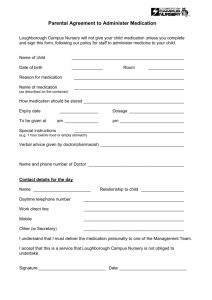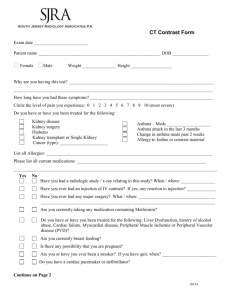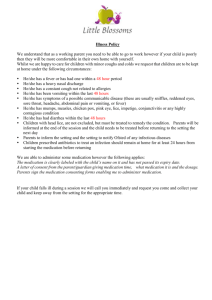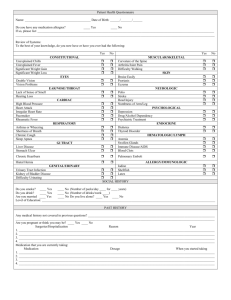APPENDIX A: Characteristics Included in the ACA Questionnaire
advertisement
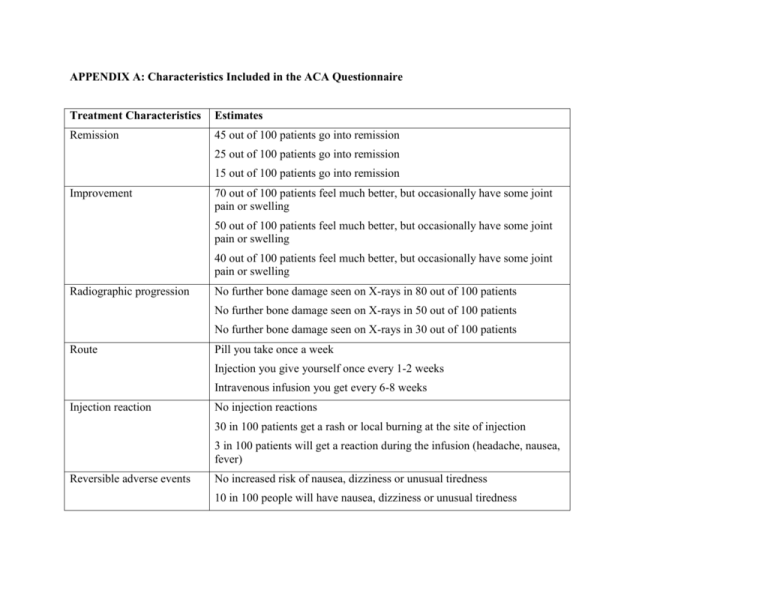
APPENDIX A: Characteristics Included in the ACA Questionnaire Treatment Characteristics Estimates Remission 45 out of 100 patients go into remission 25 out of 100 patients go into remission 15 out of 100 patients go into remission Improvement 70 out of 100 patients feel much better, but occasionally have some joint pain or swelling 50 out of 100 patients feel much better, but occasionally have some joint pain or swelling 40 out of 100 patients feel much better, but occasionally have some joint pain or swelling Radiographic progression No further bone damage seen on X-rays in 80 out of 100 patients No further bone damage seen on X-rays in 50 out of 100 patients No further bone damage seen on X-rays in 30 out of 100 patients Route Pill you take once a week Injection you give yourself once every 1-2 weeks Intravenous infusion you get every 6-8 weeks Injection reaction No injection reactions 30 in 100 patients get a rash or local burning at the site of injection 3 in 100 patients will get a reaction during the infusion (headache, nausea, fever) Reversible adverse events No increased risk of nausea, dizziness or unusual tiredness 10 in 100 people will have nausea, dizziness or unusual tiredness Risk of lung injury No increased risk of lung or liver injury Rare risk of lung injury (about 2 in 100 patients) or liver injury (about 1 in 1000 patients) Risk of tuberculosis No increased risk of tuberculosis Extremely rare risk of tuberculosis (about 1 in 10,000 patients) Extremely rare adverse events No increased risk of neurologic disease or heart failure Risk of cancer No increased risk of cancer Extremely rare risk of neurologic disease or heart failure (about 1 in 10,000 patients) Possible increased risk of cancer (about 1 in 1000 patients) Appendix B: Standardized Explanations Subcutaneous injection: An injection given right under the skin, like an insulin injection. You can give it yourself or have someone else do it. It can be given at home or in a clinic. Intravenous infusion. This means the medicine will be given to you through a needle placed in a vein in your arm. It is given by a nurse in a clinic. It will take about 2 hours to give you the full dose of medicine. Remission: This means that you do not have any joint pain, swelling or stiffness, but you still need to continue to take your medications. Reversible side effects: The arthritis medication can cause mild or moderate nausea and vomiting (you sometimes feel a little queasy and vomit about once a day). The nausea and vomiting go away after the dose of the medication is lowered, or if necessary, when the medication is stopped. Liver damage: The arthritis medication can cause liver damage. People with liver damage may become tired, weak, and lose their appetite. Many patients don’t get other symptoms, but in some, the liver damage gets worse, and can cause yellow skin, intense itching, and bloating of the stomach. Lung damage: The arthritis medication can cause lung problems that cause a dry cough, shortness of breath, and fever. Patients with this side effect need to be admitted to the hospital for treatment with oxygen and intravenous medications (steroids by vein). Treatment takes an average of two weeks. Risk of Tuberculosis (TB): Before starting the infusion medication, patients will be examined for TB with a skin test. If this test is positive, you will take a medication for 9 months and this medication will decrease the risk of TB becoming active. Heart Failure: Patients with heart failure have shortness of breath during activity or, sometimes, even without activity. It occurs when the heart doesn't pump as well as it should. Heart failure can cause fluid to build up in the legs and lungs. Neurologic disease: There have been rare cases where people taking the medication have developed disorders that affected their nervous system. Signs that indicate that you might have a problem include: changes in your vision, weakness in your arms and/or legs, and numbness or tingling in any part of the body. Risk of Cancer: Theoretical risk of cancer means that because the medication affects the immune system, it has the potential to increase cancer risk with long-term use. An increased risk has not been shown in studies of this drug in comparison with patients with RA not on medications, but the studies have followed patients for less than 5 years. If the medication does turn out to increase the risk of cancer after long-term use, the risk might be 1 in a 1000.


